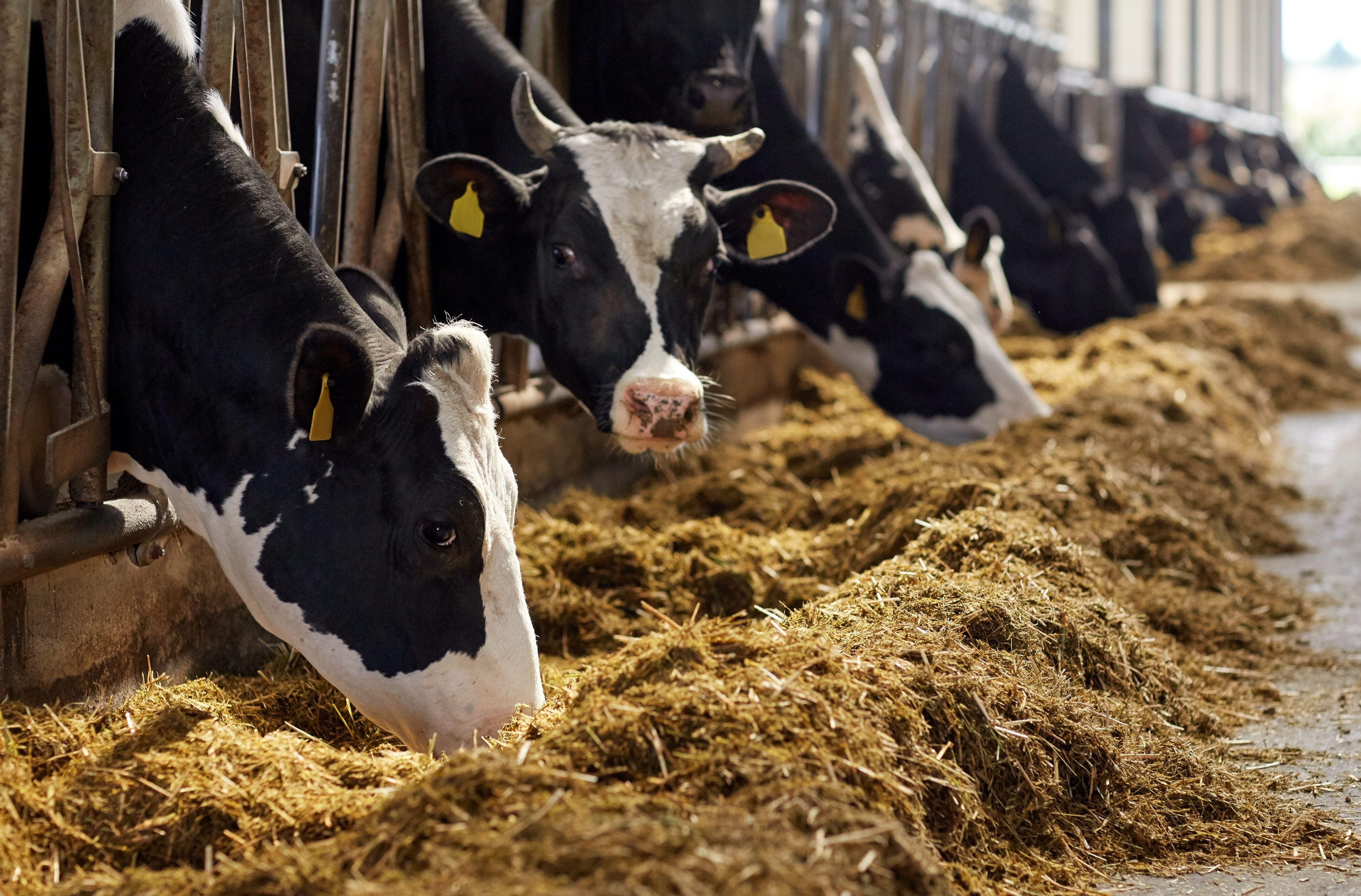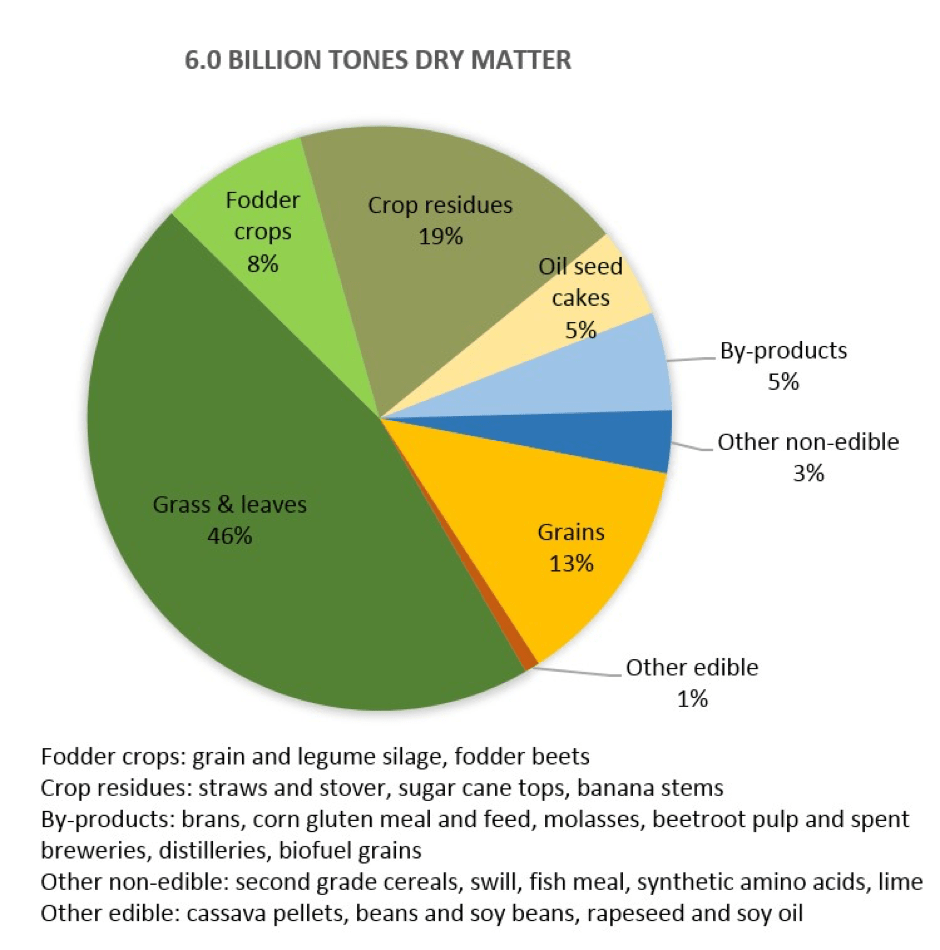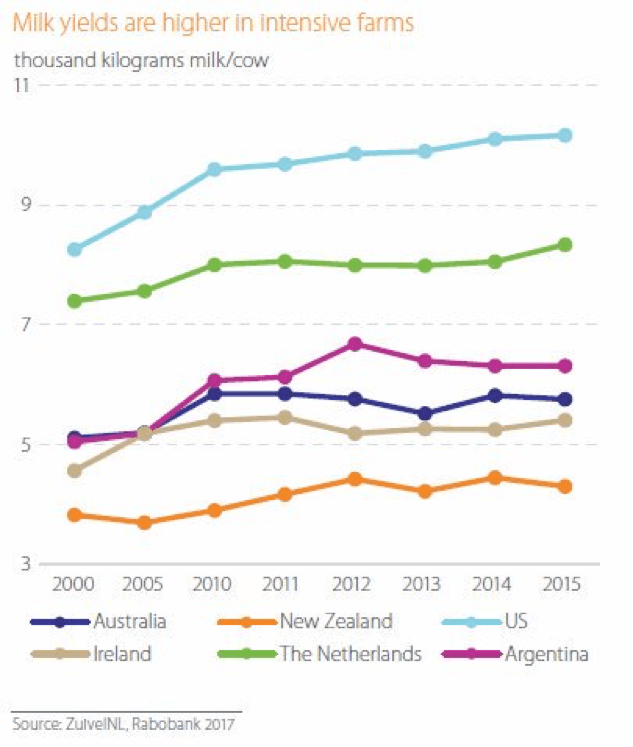Editor’s Note: David Hunt is the CEO of Cainthus, a computer vision technology company using predictive imaging analysis to monitor the health and well-being of livestock. Here he discusses dairy’s role in sustainable protein.
The most wasteful area in agriculture is animal protein.
Animal feed is also our single largest use of crops, with livestock consuming approximately 33% of global cropland. Today we are in a situation where population and technology growth are exponential functions, but the growth of these are limited by our food supply that currently increases in a linear fashion.
More food results in more well-nourished brains that can create more technology, enabling us to further increase our food supply and the cycle continues. A key solution for the future of agriculture is to turn our food system into a scalable system that works on demand, independent of natural cycles: cultured or lab-grown meat is just one example. As these demand-scalable solutions remain a long time away, it is crucial that we make our current animal protein production more efficient while we wait.
Wasteful consumption is a problem too. Japan has the highest population level longevity in the world with an average animal protein intake of 45kg per year per person. The United States, by comparison, eats 120kg of animal protein per person annually. Persuading consumers to adopt Japanese levels of animal protein consumption massively reduces stress on our environment and global food system.
For these reasons, the best way to make agriculture sustainable in the near term is to improve the efficiency of our global animal protein market.
The Best Complete Protein Source
As our global food economy marches on grasses and beans, making the most efficient use of those crops to produce animal protein is the clear sustainability goal. When you look at inputs required to produce food, there are two clear winners from an animal protein perspective: milk and eggs.
Cows eat a lot food production by-products and high-fiber, low-nutrient plants that we cannot digest. A cow is a biological agent of nutritional complexity that converts high volumes of simple, low nutrient plants to high value, highly digestible animal protein. In the chart below from the USDA, only 14% of global livestock consumption is edible by humans. For dairy cows, the proportion is even lower than this.
Poultry, however, almost exclusively eat food that is edible by humans and the same is currently true of aquaculture (maize/soy blend + fishmeal). There is some hope that in the future we can correct this by feeding animal waste to insects and then feed the insects to our poultry and fish, but this remains far in the future.
The only foodstuff that can currently compare with milk and eggs in feed efficiency are the aforementioned insects, but we have yet to see a scalable model of insect production (Protix Biosystems currently looking the best bet) and there are still major consumer acceptance obstacles for insect-based consumer foods.
With dairy, the “natural cycle free” version is bio-fermented milk (such as made by Perfect Day Foods). This process ferments genetically modified yeast with sugar to produce something that has the protein profile of cow milk. Of course, natural cow milk is a microbial symphony of activity. While not yet a true replacement, there is sufficient evidence to suggest that bio-fermented milk will be someday.
The main issues that bio-fermented milk needs to overcome are sugar source and conversion efficiency. If we need to use plant sugars, then bio-fermented milk will never become free from natural cycles. If we use another sugar source from waste (such as glycerol from feces), then we can achieve the goal. For bio-fermented milk to be commercially scalable, it will need to be produced at a price efficiency level beyond what is possible with cows (which I believe in time is readily achievable).
Dairy Sustainability Today
One of the reasons that dairy is so sustainable today is because of the emergence of Confined Area Feeding Operations (CAFO’s). As opposed to pasture systems where animals roam fields of grass, CAFO’s are mostly indoor operations where the animals have defined feeding, drinking, resting, roaming, milking areas. In these facilities animals are more tightly managed and fed, resulting in massively improved productivity.
While this seems counter-intuitive, CAFO’s produce less carbon and methane emissions per kilo of milk than pasture systems. It is comforting that a big trend in CAFO is “cow comfort” – the better cows are treated, the more milk they produce.
Dairy is currently the most efficient form of animal protein provision thanks to massive industrialization at a national scale in the US and elsewhere.
Dairy Sustainability Tomorrow
While dairy is efficient, it still has large sustainability issues that need resolving. The two largest problems in CAFO dairy today are closely related: labor & animal care.
On a traditional family farm of roughly 80 pasture cows, a farmer would know each cow and could manage them accordingly. The farmer also had free labor assistance in the form of a spouse and/or children. As traditional pasture dairy moves towards CAFO’s, these aspects of livestock farming are increasingly lost.
Labor in CAFO’s tends to have a high rate of turnover, and animal husbandry skills are learned on the job rather than absorbed during childhood. The volume of labor required to treat 8,000 cows as well as we used to treat 80 cows is cost prohibitive and a dairy farm is now closer to a corporate enterprise.
Most importantly, our ability to identify problems with animals in quick order and intervene rapidly is diminished with scale. So technology that can enable scaling of traditional animal husbandry skills to CAFO level farms is a key aspect of the future of dairy.
The first efforts at improving issue ID with dairy animals came in 1999 in the form of wearables. These wearables use gyroscopes and accelerometers to interpret behavior and activity to provide specific alerts for farmers (such as estrus & lameness). Newer dairy wearables leverage aural sensors to provide rumination data (how the animal is digesting its food).
Wearables work great on pasture, but have scaling problems when applied to CAFO’s. The complexity of use and average failure rate make wearables logistically and cost prohibitive for dairies with over 1,000 animals.
Computer vision systems are emerging that provide the benefits of wearables (and more) without the cost, scaling, and animal comfort issues that wearables have. Such systems use pelt pattern and facial recognition to identify, track, and analyze every individual animal in a herd – truly passive measurement. It is unlikely that wearables can scale traditional animal husbandry techniques, but vision systems certainly have the potential to do so. Though they will need some help from robots.
Robotic milkers are already widespread in Europe and growing in popularity in the US. Robotic feeders also exist, such as Lely’s Juno robot. Current barriers to scaling robots are mostly cost and data-based (a robot is only as useful as the data that feeds it). Today’s vision systems can provide around 2,000 data points/animal/day, many of which are intervenable. Robotic intervention at that level will be much, much cheaper than hiring humans to perform the same level of activity. The potential efficiency gains from having real-time intervention of cow health and production issues at scale cannot be overstated.
Today dairy is our most efficient form of animal protein delivery, but large efficiency improvement opportunities remain. A dairy barn of the future will likely be run by a vision system with robotic intervention overseen by an expert farmer. Such a system can provide sustainable ecological intensification required to provide animal protein for 2050 level population projections.






